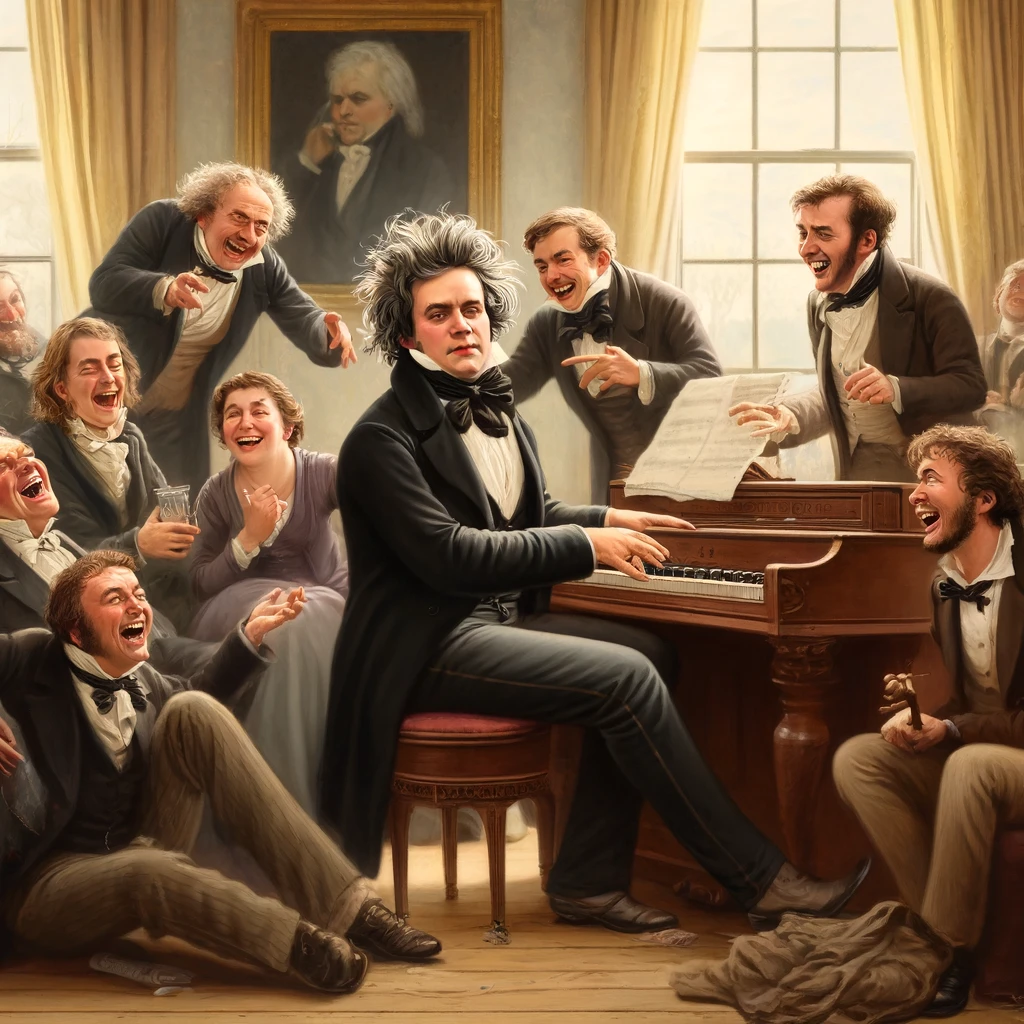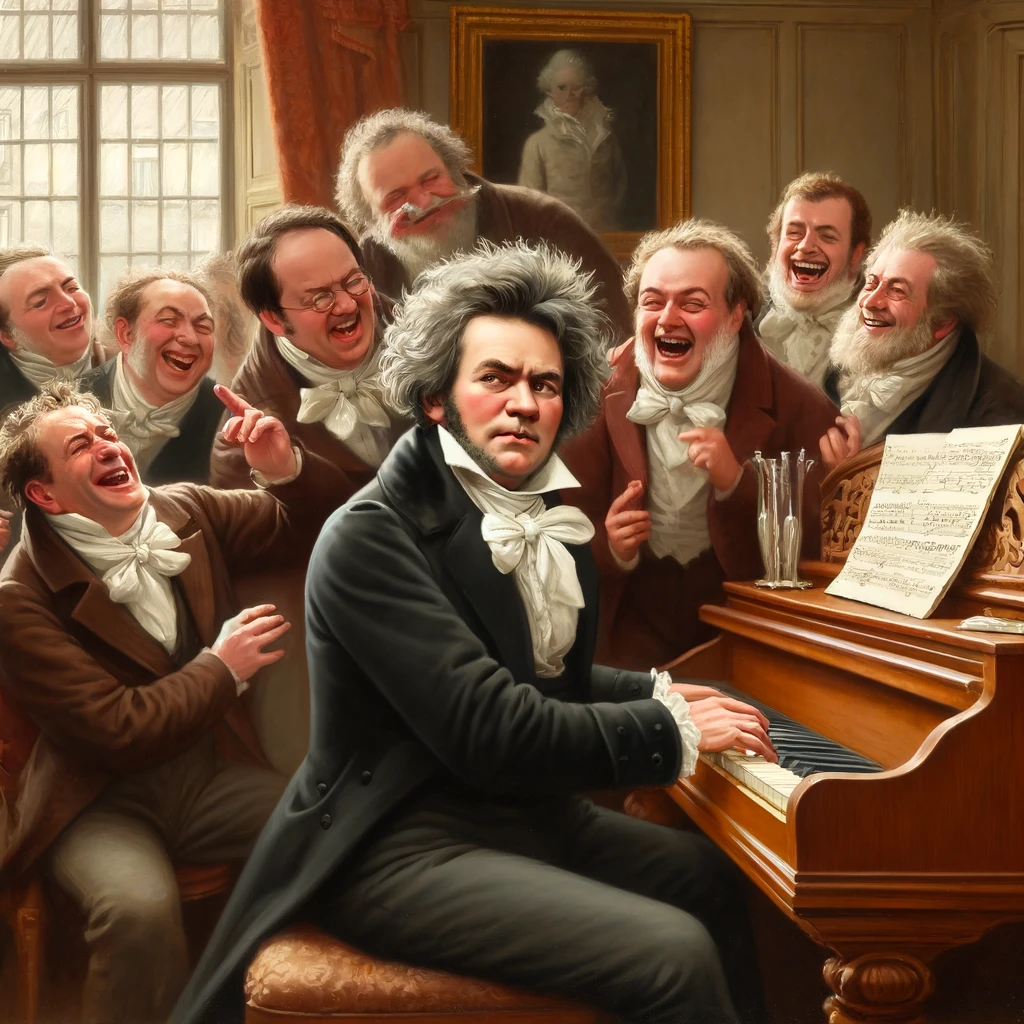
Beethoven’s Humor: Unveiling the Playful Maestro
Ludwig van Beethoven, often enshrined in the collective memory as a brooding genius, possessed a distinctly playful and humorous side, particularly evident through his musical compositions and personal anecdotes. This aspect of Beethoven not only adds depth to our understanding of his character but also enhances our appreciation of his vast body of work.
Musical Jests and Playful Compositions
Beethoven’s humor is most vividly displayed in his musical compositions, where he often deviated from the norm to surprise or even jest with his audience. For example, his Symphony No. 4 is a masterpiece that interlaces humor and light-heartedness throughout its movements. Initially set aside to work on his more famous Fifth Symphony, Beethoven’s Fourth is anything but inconsequential. It presents a contrast between a slow, brooding introduction and an explosively joyful Allegro vivace, reminiscent of a comic opera overture in its lively and unpredictable spirit.
Similarly, Beethoven’s “Rondo a Capriccio,” also known as “Rage Over a Lost Penny,” offers a humorous take on such a trivial frustration, packed with vigorous, playful melodies that seem to mock the very anger they depict. This piece, like many others, showcases Beethoven’s ability to infuse classical music with a sense of humor and irony, challenging the sober expectations often associated with the genre.
Anecdotes of a Playful Beethoven
Beyond his compositions, Beethoven’s life was replete with humorous episodes that reveal a man who, despite his struggles, embraced moments of joy and mischief. One notable instance occurred during a rehearsal of one of his operas, where Beethoven, unsatisfied with the performance of his singers, mimicked them so humorously that the rehearsal dissolved into laughter.
Another lighter aspect of Beethoven’s life was his playful interaction with children. He was known to compose little pieces on the spot to teach and entertain young visitors. This not only shows Beethoven’s lighter side but also his desire to make music accessible and enjoyable to listeners of all ages.
Beethoven’s Humorous Correspondences
Beethoven’s letters also contain flashes of wit, where he often teased friends and patrons. Despite his deteriorating health, he maintained a lively correspondence filled with jests and playful complaints about everyday annoyances. This correspondence offers a window into the more casual and humorous side of his personality, which was otherwise overshadowed by his intense dedication to music.
Reflections in Lesser-known Works
Even in his lesser-known works, Beethoven’s playful spirit is evident. His “Bagatelles,” for instance, are short, light, and often whimsical piano pieces that contrast with his more profound sonatas. These works reflect his experimental and occasionally capricious musical style, providing a broader scope of his artistic personality.
Exploring the humorous and playful facets of Ludwig van Beethoven’s personality and music allows us to see him in a more rounded, human light. It challenges the stern image typically associated with him and highlights how humor and a love for the lighter side of life permeated his work and interactions. Beethoven, much like his contemporaries, found ways to express joy, wit, and humor, making his music all the more relatable and timeless.
By delving into these lesser-known stories and deeper insights, we gain a fuller picture of Beethoven, not just as a monumental figure in classical music but as a man who embraced the full spectrum of human emotion, including the joyous and the jocular.

Influence of Literary Movements on Beethoven’s Compositions
Beethoven’s exposure to the ‘Sturm und Drang’ literary movement during his formative years also had a significant influence on his compositional style, infusing it with a sense of drama and depth that often carried a playful, ironic tone. This movement, which emphasized intense emotion and the sublime in nature, resonated with Beethoven, whose music frequently alternated between the profound and the playful. This duality is vividly present in works like his “Symphony No. 2,” where dramatic shifts in mood can almost be perceived as tongue-in-cheek comments on the very nature of symphonic music.
Public Reactions to Beethoven’s Humor
The reactions of audiences and critics to Beethoven’s humor further illuminate how his playful side was received in his own time. For instance, his “Symphony No. 8” is noted for its lighthearted and almost comedic elements, particularly in the second movement, where Beethoven mocks the metronome’s mechanical regularity with an uncharacteristically jumpy rhythm that can catch listeners off guard.
Humor Even in Adversity
Despite the severe personal challenges Beethoven faced, such as his increasing deafness, he never allowed these hardships to completely darken his compositions. Instead, he often used humor as a coping mechanism, a way to express resilience and defiance against his fate. His famous “Heiligenstadt Testament,” a letter written to his brothers expressing his anguish over his deafness, paradoxically also reflects his determination to continue living through his art. This mixture of despair and a stubborn commitment to art hints at a deeply ironic sense of humor, an acknowledgment of the absurdity of his situation.
Beethoven’s Playful Legacy
Beethoven’s ability to infuse humor and a playful spirit into his compositions and personal interactions significantly influenced the Romantic composers who followed him. His willingness to bend musical conventions and insert unexpected, humorous twists into his works opened doors for later composers to experiment with form and expression in ways that could be both profound and playfully irreverent.
Conclusion
The playful and humorous elements of Beethoven’s personality and music are essential to understanding him as a multidimensional figure. Far from the solitary, tormented genius, Beethoven embraced humor as a vital part of his creative expression and personal resilience. His ability to intertwine the tragic and comic elements of life into his compositions not only makes him a relatable figure but also elevates the richness and depth of his musical legacy.
In reevaluating Beethoven through the lens of his humor, we see not just a composer who changed the course of music history, but also a man who laughed, joked, and found joy in the absurdities of life. This perspective not only humanizes Beethoven but also makes his music all the more accessible and enjoyable for generations of listeners.